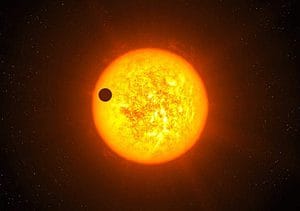
Although the Kepler Space Telescope itself is defunct due to a malfunction that rendered it out of operation some months ago, the mission goes on as scientists churn through massive amounts of data gathered by Kepler, enough to keep them busy for years to come. One of the fruits of Kepler is an exoplanet called Kepler 78b located just 400 light-years away, which apparently is the most Earth-like planet in terms of size and mass discovered thus far. The similarities end here, however. The planet completes a full orbit around its parent star every 8.5 hours compared to Earth’s steady 365-day orbit. This makes Mercury sound like the North Pole in comparison.
Kepler discovers worlds beyond our solar system by studying light. Each time a planet transits between the observational plane Kepler/parent star, a distinct wobble can be measured. Because Kepler 78b has such a short orbital period, scientists were able to gather a whole lot more data than usual, basically collecting enough data to characterize the planet in a few weeks compared to years with other exoplanets.
Each week Kepler 78b circles its star about 20 times, and based on this MIT researchers found the exoplanet is about 1.2 times Earth’s size — making Kepler 78b one of the smallest exoplanets ever measured. The mass was a lot trickier to determine, though. Each planet exerts a gravitational tug on its parent star, and this stellar motion can be detected as a very slight wobble, known as a Doppler shift. Analyzing this effects was daunting to say the least, since the star’s signal was very faint and besides starspots – dark patches on the surface of stars – also interfered with measurements.
By tracking the frequency at which certain starspots appeared and devising a set of clever calculations, the MIT researchers found the star completes a full rotation every 12.5 days and d that the star rotates relatively slowly, at 1.5 meters per second — about the speed of a jog, or a brisk walk.
“The star is moving at the same speed as when we walk to school or go grocery shopping,” notes Roberto Sanchis-Ojeda, an MIT student who was part of the research. “The difference is that this star is 400 light-years away, so imagine how complicated it is to measure such speeds from so far away.”
The most Earth-like exoplanet in terms of size and mass
Knowing the star’s true Dopler Shift, the researchers determined Kepler 78b is 1.7 times more massive than Earth. When considering size as well, this implies that the exoplanet is similar in density to Earth and that it may be primarily made out of iron and rock. So, in many ways, Kepler 78 is pretty similar to Earth, but when considering how close its is to its star, all other similarities end here.
“It’s Earth-like in the sense that it’s about the same size and mass, but of course it’s extremely unlike the Earth in that it’s at least 2,000 degrees hotter,” says team member Josh Winn, an associate professor of physics at MIT and a member of the Kavli Institute for Astrophysics and Space Research. “It’s a step along the way of studying truly Earth-like planets.”
The researchers say they still have a lot to learn about the planet, like its surface and atmospheric composition. Just earlier this month is was reported that a team of NASA scientists made the first cloud map of an exoplanet, Kepler 7b.
Artie Hatzes, a professor of astronomy at the Institute of Thuringer Landessterwarte in Germany, says this is the first Earth-like planet, in terms of mass, size, and composition, that has been fully characterized.
“This is a tricky measurement to make because the star is very active and it has starspots,” says Hatzes, who did not participate in the research. “These create a false Doppler signal often referred to as ‘activity jitter.’ You can use special tricks to disentangle the Doppler wobble due to the planet, and the Doppler velocity variation caused by the spots on the star. If the planet had a much longer orbital period, it would be much more difficult to do so.”
The exoplanet Kepler 78b was characterized in a paper recently published in the journal Nature.






